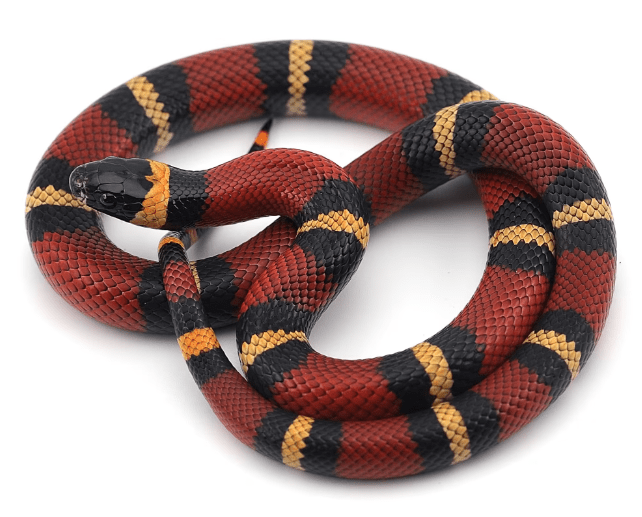
Description
Scientific Name: Lampropeltis triangulum
Lifespan: 15 years in the wild, and maybe 20 years or more in captivity.
Milk snakes often have smooth, glossy scales with alternating bands of red-black-yellow or white-black-red colouring. However, red dots rather than bands can be found in some populations. Red, black, and yellow transverse bands can be found on coral and milk snakes alike. Males are normally larger than females when they reach maturity, while females might occasionally be bulkier than males of a similar length. Generally speaking, milk snakes residing in temperate zones grow smaller as adults than populations from Mexico and farther south that are more tropical.
Native Region/Habitat
In the midwest, from central Minnesota to Nebraska, Colorado, and the Dakotas; in the foothills of the Appalachian Mountains; Kentucky, Tennessee, Georgia, Oklahoma, Texas, Arkansas, Kansas, and Louisiana; and from the southeastern extreme of Ontario, Canada,to the southeastern states of the Eastern Seaboard, south to Florida, Mississippi and Alabama.
Habitat varies across the vast range of this species; normally, milk snakes prefer to reside in forested settings or open woodland areas. They can also be found in some semi-arid/chaparral environments, wetlands, prairies, cropland, rocky slopes, and sand dunes/beaches.
Behavior
Most of the time, milk snakes are nocturnal, particularly in the summer. They mostly live on land, and they try to seem like ground clutter. However, they can swim and climb. These snakes prefer to be covert and keep to themselves. A milk snake will typically make an attempt to flee if it feels threatened. Even though they are non-venomous, have only very little teeth, and don’t have rattles on their tails, if trapped or harassed, they may vibrate their tail and strike ferociously. Milk snakes move slowly unless they are startled. They frequently exhibit docility.

Care as a Pet/In Captivity
Enclosure:
A 10-gallon tank is sufficient for a youngster; however, to accommodate a medium-sized adult, increase habitat to a 20-L tank. Depending on the species and under perfect circumstances, they will mature into adults in 3 years. Larger snakes need 40B tanks to live in. Give an adult milk snake the right size and shape of habitat so it can behave normally, including stretching out and exercising. The top of the habitat should be a closely fitting screen to allow for proper ventilation while preventing escape.
Humidity:
A water dish big enough for the snake to soak in should be included in the habitat to maintain humidity levels, keep the snake hydrated, and help with shedding. Maintain a humidity level of 40% to 60% and use a humidity gauge to check it. During shedding, the humidity should be higher. By establishing a damp hide with moist sphagnum moss, humidity can be increased during shedding.
Temperature:
Since snakes are ectothermic reptiles, their body temperature is regulated by the ambient temperature. Provide a temperature gradient in the tank (85°F for the warm end and 70–75°F for the cool end/nighttime) to aid in their ability to regulate their body temperatures. Use at least two thermometers to keep an eye on the temperature—one in the cold area and the other in the hot (bathing) area.
Diet & Water
Pinky mice that have been defrosted should be fed to milk snake hatchlings once a week. As the snake grows, the meal portion should be increased until it is eating giant or even gigantic mice. Adult milk snakes should only be fed every two weeks because feeding them every day could result in weight gain. On the chilly end of the enclosure, there should be a water bowl big enough for the snake to fit into.
Table





